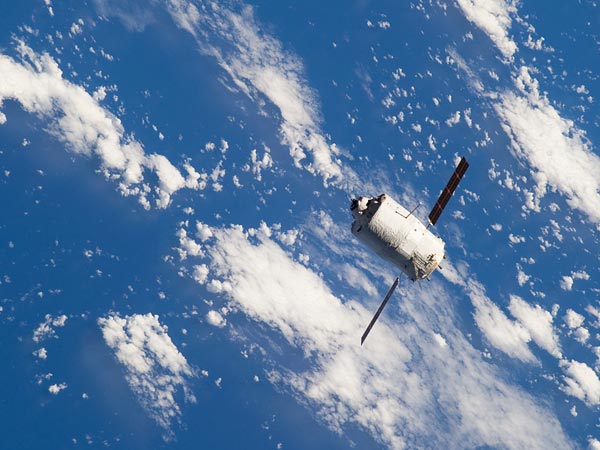A spacecraft stuffed with garbage - including astronaut urine - will tumble back to Earth Tuesday, becoming a fireball over a remote section of the Pacific Ocean.
The European Space Agency launched the unmanned craft, called the Johannes Kepler automated transport vehicle (ATV), in February to deliver several tons of cargo to the International Space Station, including food, supplies, fuel, and oxygen.
The glorified space freighter isn't designed to safely return to Earth, so during the past four months space fliers on the ISS have crammed the 450-million-euro (640-million-dollar) canister with 1.3 tons of junk.
"They pretty much filled it to the brim, mostly with packing material from inside modules recently delivered to the space station," said Kelly Humphries, a NASA spokesperson at Johnson Space Center in Houston, Texas.
Other garbage inside the ATV includes dirty clothes, food containers, broken equipment, and pretty much anything else the crew no longer wants on board.
"There's also containers of processed urine from the water-recycling system. It's nasty stuff," Humphries said.
Spaceship to Become Dazzling Fireball
The Johannes Kepler ATV successfully undocked from the ISS Monday around 10:50 a.m. ET (16:50 CEST).
If all goes as planned, two burns of propellant will slow the Johannes Kepler until it drops toward Earth, ultimately disintegrating somewhere northeast of New Zealand around 4:50 p.m. ET (22:50 CEST) on Tuesday.
Upon reentry, the craft should put on a dazzling display like that of the Jules Verne ATV, Kepler's older brother, which exploded into a shimmer on September 29, 2008.
But, as with the Jules Verne, no one except maybe a few unlucky fish should be in harm's way of the debris shower.

"That information will help us learn more about how spacecraft break up in general and develop better ones in the future," Humphries said.
Kepler Gave ISS a Needed Boost
ESA's ATV is the roomiest disposable spacecraft design in existence, at 1,700 cubic feet (48 cubic meters). Russia's expendable Progress spacecraft, by comparison, has only 233 cubic feet (6.6 cubic meters) of pressurized cargo space.
The next ATV, to be named after physicist Edoardo Amaldi, is currently scheduled to launch in February 2012.
Humphries added that the Johannes Kepler did more than deliver crucial supplies and serve as an 11-ton garbage can for the space station.
As the ISS moves in low-Earth orbit, the thin outer wisps of our planet's atmosphere drag on the 460-ton orbital laboratory and gradually slow it down.
With gentle thrusts of its boosters June 3, 12, and 15, the docked ATV lofted the nearly 440-ton ISS into an orbit 237 miles (381 kilometers) above Earth - about 20 miles (32 kilometers) higher up than it had been before.
"Kind of like a car, the space station has a sweet spot," Humphries said. "This [added boost] puts it right into that sweet spot so we don't need to use as much fuel to keep it in orbit."




...way to waste €450 million when europe is bankrupt...